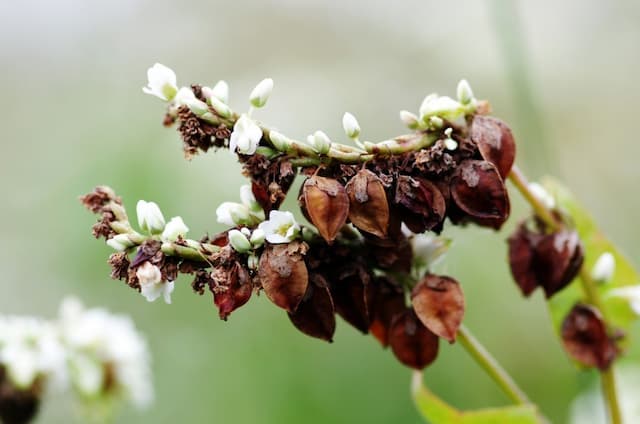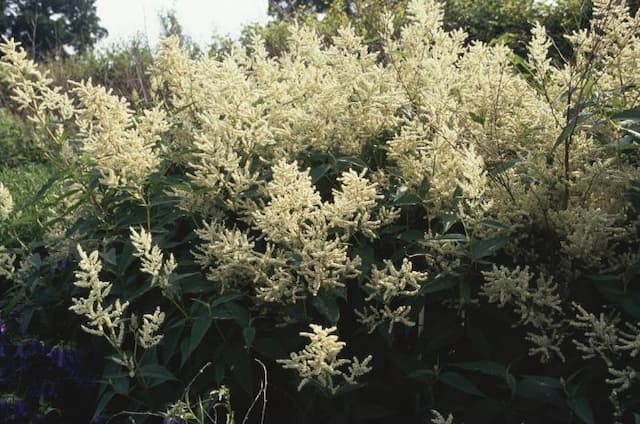Broad-leaved Dock Rumex obtusifolius

ABOUT
The plant commonly known as broad-leaved dock is distinguished by its broad, oval to heart-shaped leaves that have a slightly wavy or crinkled margin. The leaves are typically dark green and can have a leathery texture with a somewhat glossy surface. The stems are sturdy, often reddish, and support the plant's structure well. This plant produces small flowers grouped in clusters along with branching flower stalks, creating a tall inflorescence. The flowers are not particularly showy and are usually greenish or reddish-brown. As the plant matures, the flowers give way to hard, dark brown seeds encased in a papery structure. One notable characteristic of broad-leaved dock is its deep and stout taproot, which is frequently responsible for the plant’s tenacity and ability to thrive in a variety of conditions. The root system makes it resistant to many methods of control, contributing to its reputation as a weed in many regions. Throughout its growth, the broad-leaved dock has a robust nature that can dominate the surrounding vegetation if left unchecked. Despite its persistent weedy reputation, the plant is known to have been utilized historically for various purposes, including medicinal uses, due to its array of constituents.
About this plant
 Names
NamesFamily
Polygonaceae.
Synonyms
Broad-leaved Dock, Bitter Dock, Bluntleaf Dock, Dock Leaf, Broad Dock, Butter Dock, Kettle Dock, Smear Dock, Smear Dock, Blunt-leaved Dock, Red-beet Dock, Water Dock.
Common names
Rumex obtusifolius var. subalpinus, Rumex salicifolius var. subalpinus, Rumex sylvestris, Lapathum obtusifolium, Acetosa obtusifolia, Lapathum acutum, Rumex aquaticus var. fenestratus, Rumex conglomeratus var. subalpinus.
 Toxicity
ToxicityTo humans
Broad-leaved dock is a plant with some levels of toxicity due to its oxalic acid and tannin content. Ingesting it can cause issues, particularly if consumed in large quantities. Symptoms of poisoning may include stomach pain, nausea, vomiting, and diarrhea. Kidney problems could also potentially arise due to the oxalate content, which can contribute to kidney stone formation. Oxalic acid can also interfere with calcium absorption in the body.
To pets
Broad-leaved dock is similarly toxic to pets due to the presence of oxalic acid and tannins. Consumption by pets can lead to gastrointestinal irritation, resulting in symptoms such as drooling, vomiting, and diarrhea. More severe cases, especially with significant ingestion, could potentially cause kidney damage or complications from decreased calcium absorption. In pets, it is particularly important to seek veterinary attention if you suspect they have ingested a substantial amount of the plant.
 Characteristics
CharacteristicsLife cycle
Biennials
Foliage type
Deciduous
Color of leaves
Green
Flower color
Green
Height
3-4 feet (0.91-1.22 meters)
Spread
2-3 feet (0.61-0.91 meters)
Plant type
Herb
Hardiness zones
5
Native area
Europe
Benefits
 General Benefits
General Benefits- Animal feed: Broad-Leaved Dock can serve as forage for livestock when other food sources are scarce.
- Soil improvement: This plant can help to prevent soil erosion and improve soil structure due to its deep root system.
- Wildlife habitat: Provides shelter and food for various species of wildlife, including insects and birds.
- Biodiversity support: Contributes to the ecological diversity of an area by providing resources for different organisms.
- Companion planting: Can be used in companion planting to ward off certain pests naturally.
 Medical Properties
Medical Properties- Astringent: Rumex obtusifolius, commonly known as broad-leaved dock, has been traditionally used for its astringent properties to help tighten tissues and alleviate bleeding.
- Laxative: It may be used to relieve constipation due to its laxative effects.
- Anti-inflammatory: The plant has been used to reduce inflammation, particularly in cases of skin irritation or bites.
- Alterative: Believed to support the body's cleansing processes and general detoxification.
 Air-purifying Qualities
Air-purifying QualitiesThis plant is not specifically known for air purifying qualities.
 Other Uses
Other Uses- Rumex obtusifolius, commonly known as broad-leaved dock, can be used as a natural dye, imparting colors from soft yellows to deep rusts, depending on the mordant used.
- The leaves of broad-leaved dock can serve as a food source for livestock, although care must be taken due to the potential for nitrate accumulation in the foliage.
- Despite being an irritant to some, the seeds of the plant have been used as a mild abrasive in polishing tools or as a scouring agent.
- The leaves, when harvested young and tender, can be cooked like spinach after boiling to reduce oxalic acid content, making for a traditional, albeit less known, wild green.
- Its robust roots are sometimes carved into makeshift tools or toys by those skilled in traditional handicrafts.
- In some cultures, broad-leaved dock is a natural indicator plant, suggesting that land is high in fertility and could be good for growing crops.
- When dried and burned, the plant has been traditionally used as an insect repellent due to its acrid smoke deterring flies and mosquitoes.
- The dead stalks of broad-leaved dock, being tough and fibrous, have been used in rural areas to make simple string or twine for binding purposes.
- With caution for the sharp edges, the large leaves have historically been repurposed as makeshift container lids or as a wrapping material to preserve foodstuffs.
- Traditionally, the strong root system was sometimes utilized to prevent soil erosion on slopes or areas prone to land disturbance.
Interesting Facts
 Feng Shui
Feng ShuiThe Broad-leaved Dock is not used in Feng Shui practice.
 Zodiac Sign Compitability
Zodiac Sign CompitabilityThe Broad-leaved Dock is not used in astrology practice.
 Plant Symbolism
Plant Symbolism- Persistence: Rumex obtusifolius, commonly known as Broad-leaved Dock, is known for its hardy and persistent nature. It can thrive in various conditions, symbolizing the ability to endure and remain steadfast through challenges.
- Healing: Traditionally, the Broad-leaved Dock has been used for its medicinal properties to soothe nettle stings, representing its association with natural healing remedies and relief from pain.
- Adaptability: As a plant that can grow in diverse habitats, Broad-leaved Dock symbolizes adaptability and the capacity to adjust to different environments and situations.
 Water
WaterBroad-leaved dock should be watered moderately, as overwatering can lead to root rot. During the growing season, ensure the soil remains moist but not waterlogged; typically, watering once a week with one gallon of water should suffice, depending on the local climate and weather conditions. Reduce the frequency during the winter months when the plant is not actively growing. It's essential to use a method that allows for deep watering, encouraging the roots to grow downwards. Make sure to water the soil directly, avoiding wetting the foliage to prevent disease.
 Light
LightBroad-leaved dock thrives in full sunlight to partial shade. The best spot for planting would be an area receiving at least six hours of sunlight daily, but it can also tolerate lower light conditions. Avoid locations with full, intense afternoon sun, which might be too harsh.
 Temperature
TemperatureThe broad-leaved dock prefers a temperature range between 50°F and 75°F but can survive in temperatures as low as 20°F and as high as 90°F. The ideal temperature conditions fall within the moderate climate range, ensuring healthy growth.
 Pruning
PruningPruning broad-leaved dock is primarily for controlling its spread and removing old, damaged foliage. Prune as needed by cutting back any flower stalks to prevent seeding. The best time for pruning is late fall or early spring before new growth begins.
 Cleaning
CleaningNot needed
 Soil
SoilBroad-leaved dock prefers moist, nitrogen-rich soils with a slightly acidic to neutral pH of around 6.5 to 7. A mix of garden loam, compost, and organic matter would make an ideal soil composition for this plant, providing good drainage as well as fertility.
 Repotting
RepottingBroad-leaved dock is a perennial weed often not cultivated in pots. In natural settings, repotting isn't applicable. If grown in containers for study, repot it every 2-3 years to replenish soil nutrients.
 Humidity & Misting
Humidity & MistingBroad-leaved dock is not overly sensitive to humidity levels and thrives in average outdoor conditions. It does not require specific humidity adjustments when grown outdoors in its typical environment.
 Suitable locations
Suitable locationsIndoor
Broad-leaved dock rarely grows indoors; prefers outdoor settings.
Outdoor
Plant broad-leaved dock in rich, moist soil; ensure regular weeding.
Hardiness zone
4-8 USDA
 Life cycle
Life cycleBroad-leaved dock (Rumex obtusifolius) begins its life as a seed that germinates in the spring when soil temperatures and moisture levels are suitable. The seedling emerges and forms a rosette of large, oval green leaves on the ground, which can undergo considerable growth in its first year. The plant then develops a deep tap root which allows it to survive through the winter and adverse conditions. In its second year or later, the broad-leaved dock produces a tall flowering stalk that can reach over a meter in height, bearing numerous small greenish flowers that are wind-pollinated. After flowering, the plant sets seeds that are encased in a fruiting structure, and these seeds can remain viable in the soil for many years. The parent plant eventually dies after seeding, but the long-lived seeds ensure the persistence of the species in the environment.
 Propogation
PropogationPropogation time
Spring to early summer
The most popular method of propagation for Broad-leaved Dock (Rumex obtusifolius) is through seed dispersal. Ideally, this happens during the fall, where the seeds are naturally dispersed, but for cultivation purposes, seeds are sown in early spring. Sow the seeds shallowly at a depth of around half an inch (1.27 cm) in well-drained soil and space them approximately 12 inches (30.48 cm) apart to allow for adequate growth. The seeds will typically germinate within a couple of weeks, given appropriate moisture and temperature conditions. Once established, Broad-leaved Dock can be quite hardy and can thrive in a variety of soil types, though it prefers moist, nitrogen-rich soils.







![Red bistort [JS Seven Oaks Village]](/_next/image?url=https%3A%2F%2Fplants-admin.emdemapps.com%2Fimages%2Fplants%2F%2Fimages%2F604b56557c0e3.png&w=640&q=75)

